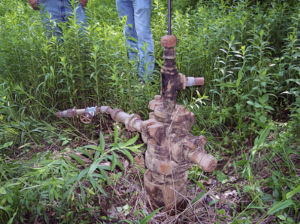
The oil and gas industry has embedded itself into Pennsylvania’s economy by drilling upwards of 395,000 wells in the state. However, Pennsylvania’s Department of Environmental Protection (“DEP”) estimates that at least 200,000 of these wells are either abandoned or orphaned. An abandoned well is one that has not been used to produce, extract, or inject within the preceding year; for which the equipment necessary for production, extraction, or injection has been removed; or that is considered dry and not equipped for production within sixty days after drilling, redrilling, or deepening. Orphaned wells are those that were abandoned prior to April 18, 1985, and have “not been affected or operated by the present owner or operator and from which the present owner, operator, or lessee has received no economic benefit other than as a landowner or recipient of a royalty interest from the well.” Each abandoned well can emit up to 419 pounds of methane per year and leak toxins into our waterways, which has a negative impact on the health of Pennsylvanians. Not only can it affect our health, but methane has 86 times the effects of carbon dioxide related to global warming. To help solve the problem of abandoned oil and gas wells, the United States government passed the Infrastructure Investment and Jobs Act (“IIJS”), including a $4.7 billion investment into plugging these wells. Of that investment, Pennsylvania could receive up to $400 million over the next ten years to plug abandoned wells, $104 million of which we should see this year.
The history of plugging abandoned wells in Pennsylvania began in 1989 when the first well was plugged with funds from the Abandoned and Orphaned Well Plugging Program, which the DEP administers. The Abandoned and Orphaned Well Plugging Program is currently funded through permit surcharges. Since the program started, DEP has plugged at least 3,000 abandoned or orphaned wells at an estimated cost of $68,068 per well. That is a total cost of $204,204,000 that the Commonwealth has spent over 33 years. Thus, the investment from the IIJA would provide the state with more than half of the funding the entire program has had this year alone.
Pennsylvania State House Bill 2644
Last month, PA State Representative Martin Causer introduced House Bill (“HB”) 2644, which allocates the funding Pennsylvania will receive from the federal infrastructure investment. The bill is moving quickly: it passed in the State House on June 20, 2022, and was given second consideration in the State Senate on July 6, 2022. HB 2644 would send the federal investment from the IIJA to two different sources. Eighty percent ($83.2 million) of the funding would be sent to the Orphan Well Plugging Fund, allowing the DEP (on average) to plug an additional 1,200 wells. The other twenty percent ($20.8 million) would be distributed through the bill’s grant program.
The Grant Program Does Not Distribute Enough Funding Per Well
The grant program would award qualified well pluggers (“QWP”) money to plug eligible wells. An abandoned or orphaned well must meet the following to be considered eligible: it has not been plugged in accordance with state requirements, no amount of bond is available to pay for its plugging, and no person who is financially responsible for plugging it is known to the department or likely to be identified.
A QWP would receive $10,000 for every eligible well plugged with a depth of 3,000 feet or less and $20,000 for every eligible well plugged greater than 3,000 feet after they applied for, were approved to, and actually plugged the well. However, the amount of the grant can be increased if the QWP experiences difficulties while plugging a well. Additionally, DEP may increase the amount of funding per grant if they do not receive an adequate number of applications by posting the increased amounts on their website.
As mentioned above, DEP estimates that it costs close to $70,000 on average to plug one well, an amount way above the current maximum grant amount. The legislature should grant QWPs the proper funding necessary to plug the well from the outset, not wait to see if there are enough applications or if the operators are having difficulties before raising the grant amount. This would decrease any delay in well plugging due to a lack of adequate funding. If each grant were worth $68,068, QWPs would be able to plug at least 300 abandoned or orphaned wells.
HB 2644 Attempts to Change Bonding for Conventional Wells Again
As discussed in a previous blog post, the issuance of a new conventional well permit requires the operator to buy a bond from DEP to cover the costs of sealing the well if they are financially unable to do so after they have finished extracting the oil or gas. Operators can purchase either a single well bond or a blanket bond. Blanket bonds allow the operator to purchase one bond that covers all of their wells within the state instead of buying a bond for each individual well. Currently, the cost of each bond varies depending on how deep the well is and how many wells an operator owns. Still, the largest possible bond amount is $600,000 for an operator that operates wells with a depth in excess of 6,000 feet and has more than 150 wells in the state. The maximum bond amount is only enough to plug eight wells.
While HB 2644 allocates funding Pennsylvania will receive from the IIJA, it is also another attempt to change bonding for conventional oil and gas wells. The last time our legislature tried to change the bonding for these wells was during the previous legislative session, but Governor Wolf vetoed that effort on November 25, 2020.
HB 2644 would change the bonding amount for a single, unconventional well to $2,500 per well. However, if an operator wants to file a blanket bond for all of their conventional wells, it would cost $25,000. Every well that an operator drills after purchasing a blanket bond will cost an extra $1,000 – but the total bond amount cannot exceed $100,000. If an operator has plugged an abandoned or orphaned well within the previous year at their own expense, the $1,000 price tag for an additional well will be waived.
There are several issues with changing the bonding for conventional wells to the scheme contained within HB 2644. First and foremost, $100,000 is not enough to cover the cost of plugging even two wells if the operator becomes financially unable to do so. Because $100,000 is at the very top of the cost spectrum, the operator with that size bond likely has hundreds of wells in the state. Additionally, if an operator has purchased a blanket bond but wants to drill a new well, they have the option to either pay $1,000 or to plug an abandoned or orphaned well at their own expense. It is obvious that operators will choose to pay the $1,000 rather than pay close to $70,000 to plug a new well, thus the price tag for new wells under a blanket bond needs to be higher. Lastly, this places a costly burden on the taxpayers. Currently, the IIJA funds come from federal tax dollars – which means we are personally paying for the benefits the Act confers. However, what HB 2644 does is place the operator in the position to invest more of its money into operations and less into bonding – the insurance that protects our Commonwealth. Thus, if an operator, under the scheme of HB 2644, goes bankrupt, the taxpayers of Pennsylvania are left with the bill of plugging all of its wells.
As part of the provision that changes the bonding of conventional wells, the bill would also prohibit the Environmental Quality Board, an independent body that adopts and recommends regulations for the DEP, from further changing the bonding amount for those wells. This means that if a future government wanted the bonding amount to reflect the actual cost of plugging abandoned wells, they would have to go through the General Assembly, which is a timely and difficult process.
With this year’s funding from the IIJA, Pennsylvania will have the potential to plug up 1,500 more wells, but this is only a drop in the bucket compared to the number of abandoned and orphaned wells remaining in Pennsylvania. To ensure that we can plug the maximum amount of wells, legislators in the Senate should amend this bill so that the grant and bonding amounts reflect the actual cost of plugging abandoned and orphaned wells. Without these changes, the small amount of progress we could make will be even less.
If you live in Pennsylvania, you can take action below to ask Governor Wolf to veto this bill so Pennsylvanians don’t have to continue to bail out the oil and gas industry:

